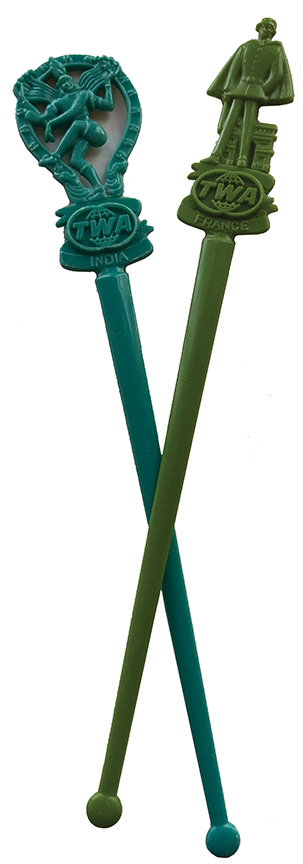
Dorri Partain
Contributor
Stirred, not shaken. Whether called cocktail stirrers or swizzle sticks, these colorful plastic sticks make great souvenirs of one’s travels.
Back when all airlines offered full meals and alcoholic beverages, a variety of styles either highlighted airplanes or destinations. The destinations series, offered to TWA travelers during the 1960’s, showcased eight locations that could be reached using TWA: Africa, England, France, Greece, Hong Kong, India, Italy and Spain.
The original swizzle stick came from the Quararibea turbinata tree; also known as the swizzle stick tree, the unusual branches were perfect for mixing a Caribbean concoction of rum, sugar, and water. Later, the branches were duplicated in glass or metal for those too refined to use a branch, such as Queen Victoria who liked to stir her champagne to reduce the bubbles.
Following the end of Prohibition in 1933, inventor Jay J. Sindler of Boston, Mass., was looking for a neater way to remove the olive from his martini when he developed the first commercial stir stick, the STIR-IT. Made of thin wood, his stirrer was shaped like a tiny oar with a point on the end for spearing olives or cherries in drinks. Patented as an “eating implement” in 1935 (US No. 1,991,871) the paddle and handle could be imprinted with red ink to advertise a product or location.
Transcontinental & Western Air (TWA) was formed when five smaller air companies merged to receive airmail contracts from the United States Postal Service. Tycoon Howard Hughes acquired TWA in 1939 and expanded its flight services to Europe, Asia and the Middle East, and thus changed the company name to Trans World Airlines in 1950. Kansas City served as the company’s headquarters from 1931, and flight hostesses were trained in their downtown office at 1735 Baltimore from 1956-1969, when a new training center, Breech Academy, was completed in Overland Park, Kan.
After a series of bankruptcy filings, TWA was acquired by American Airlines in 2001 and eventually all traces of TWA were erased. Former TWA employees have since created the TWA Museum, located at the Downtown Wheeler Airport, where a full array of airline and TWA memorabilia is on display. Visit www.twamusuem.org for more information.
















